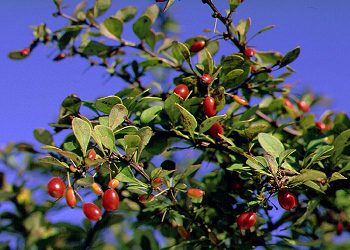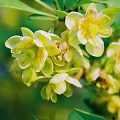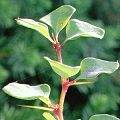MegiBerberis thunbergii - Japanese Barberry
Tangled, very prickly, but attractive foliage (June 2000)
|
|
A few years ago, I encountered the bush above on a local mountain, recognised it, and took it home. Sort of forgot, and left it in the midsummer sun for enough hours that it easily passed for dead, but then I stuck it in the ground. It has flourished since, in its extremely thorny way.
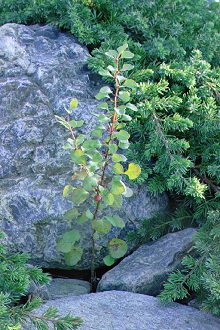 This "volunteer" appeared at the side of our front path, sometime in 2000. (Photo: November 2000) Full size (400x600 89KB) |
I recognised it as Berberis, of course, a fairly common shrub in English garden centres, and generally known by that name rather than the traditional "barberry" label. But no-one I asked seemed to know what it was called in Japanese, so (no web searches then!) I had to resort to that most unreliable of tools, the English-Japanese dictionary (Kenkyusha's Shorter), which assured me in print that it was a hebinoborazu (Lit. "snake-won't-climb"). Fine, except nobody seemed to have heard of that either, and I couldn't then find it in a Japanese dictionary. Eventually I think I saw one in a garden centre, and learned that it's megi (Lit. "eye-tree"), so named because traditionally infusions of the twigs and leaves were used as medicine for the eyes. It turns out that hebinoborazu is a particular variety, which grows in Western Japan, and has become very rare. (See link below.)
What sort of plant is it? Well, it makes a highly animal-proof hedge, but such things aren't much in demand hereabouts. Generally it seems not to be regarded as a garden plant in Japan, and doesn't appear in gardening books. After all, it isn't very showy: the flowers are a beautiful creamy colour, but when they appear (April-May), hardly stand out from the greenery they hang under. The berries, which appear in late autumn, are bright red, but don't form really eye-catching clusters.
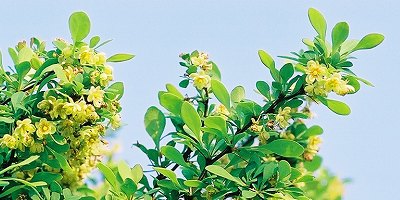 Clusters of flowers - this doesn't really do justice to the very delicate creamy colour of the blossom. Remember that the individual flowers are only a few millimetres in diameter. (Photo: April 2001 - Whole image 800x500 127KB)
|
Thumbnails |
|---|---|
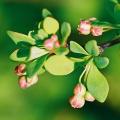 The early flower buds are tinged with pink. 4 April 2001 (750x500 74KB)
|
 And the names?
And the names?
Perhaps not surprisingly, it turns out that the common English barberry is Berberis vulgaris. Presumably the Japanese species, named after Thunberg, one of the great plant explorers of Japan, is thought more exotic, and has turned into the standard berberis for horticultural purposes.
![]()
Links
In EnglishAmericaNew Mexico State University site shows the purple variety (Berberis thunbergii atropurpurea according to my English shrub book) BritainRyedale Natural History Society page shows a photo of the common barberry, and suggests it is becoming quite rare. |
In JapaneseMiyazaki University page on hebinoborazu (includes photo) |


